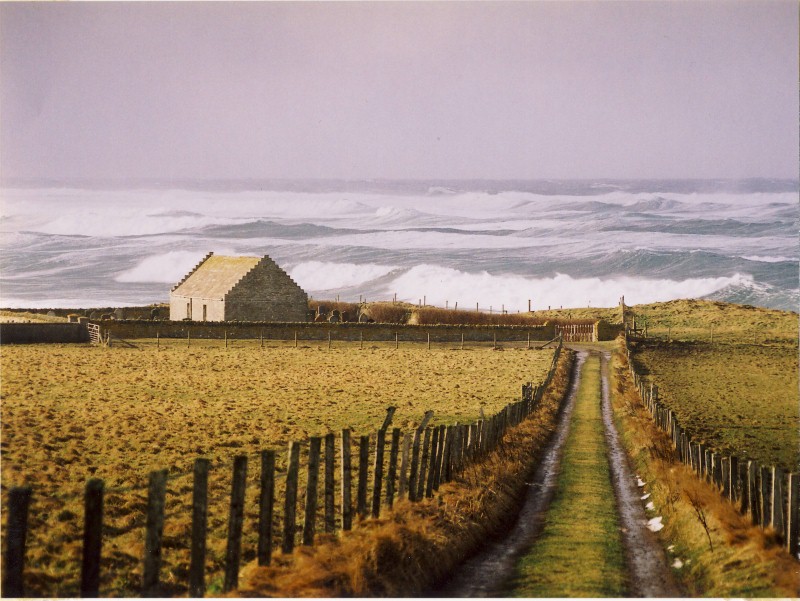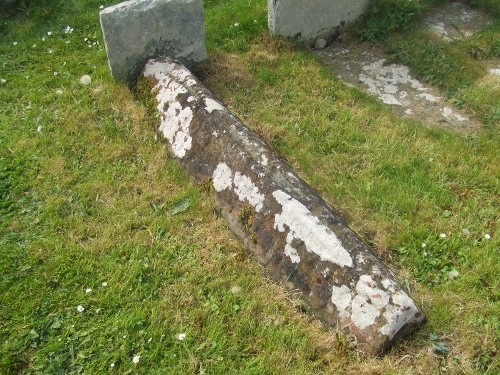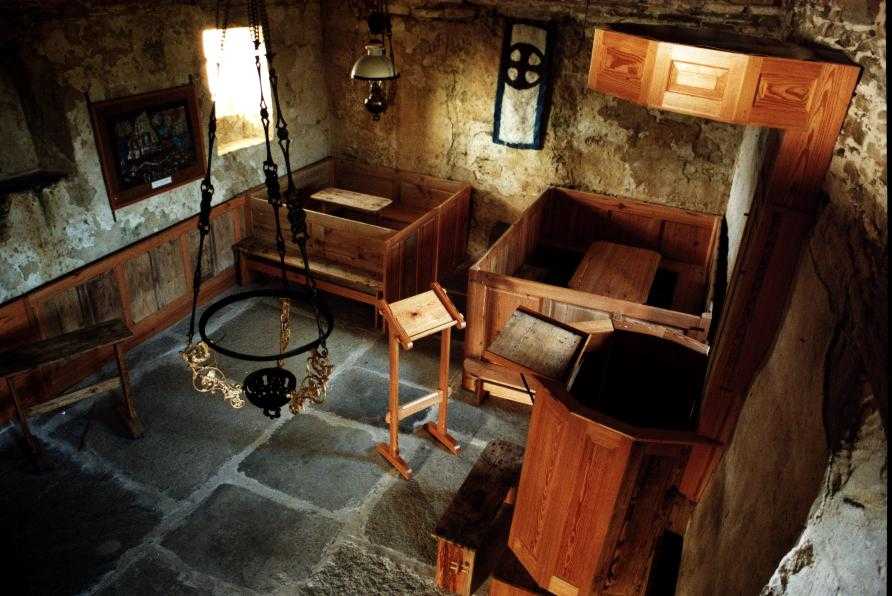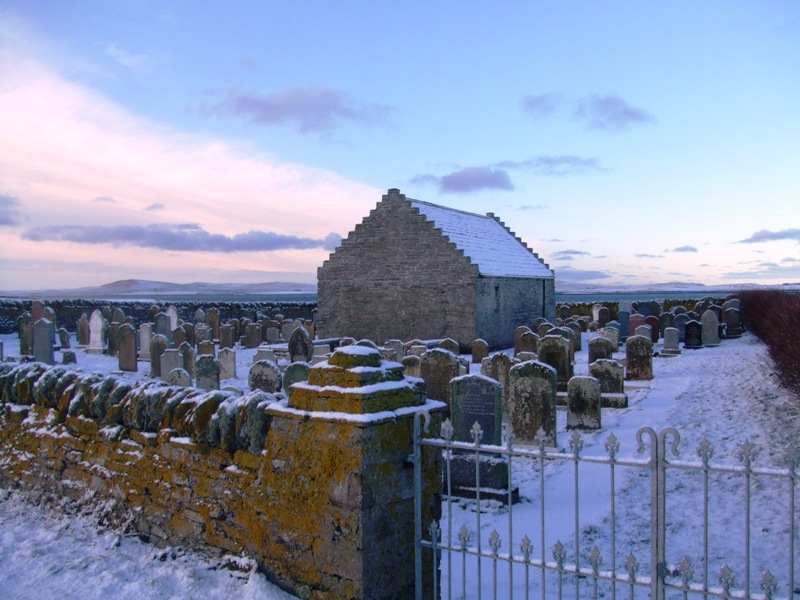
St Boniface Kirk, Papa Westray - photograph by Douglas Hourston St Boniface Kirk
Now restored, St Boniface Kirk is set in an important ecclesiastic site dating back to the 8th century. It stands above the rocky shore towards the north west of Papa Westray. It has Iron Age, Pictish and later remains nearby, dating from the 6th century BC to 12th century AD. A Norse hog-back gravestone and two Early Christian cross-slabs found in the Kirkyard all combine to indicate a site of great significance.

Hogback tombstone in St Botolphs kirkyard
Interior view of restored church - photograph by Douglas HourstonThe Kirk is dedicated to St Boniface (675 to 754 AD) a famous teacher and missionary, working in Friesia and Germany, becoming a bishop in 722 AD and archbishop in 732 AD. He established many new churches, monasteries and bishoprics before being murdered in 754 AD.
One interpretation of the story of St Boniface Kirk on Papay involves the Pictish King Nechtan who was conversion to the Roman Church around 715 AD. He formed an alliance with the kingdom of Northumbria and invited the clergy to establish a well ordered Christian mission through his domain. Many churches and monasteries were on or near the sites of brochs, iron age fortified towers, indicating an important place of power. This is the case with St Boniface Kirk.
As St Boniface met his fate whilst the mission to convert the Picts was spreading its network of churches and monasteries in the north, to Orkney and Shetland, the church built on Papay may have been dedicated to him at this time.
Beach Find Reveals Its Saintly Past
A CHANCE find by holidaymakers on a remote Orkney beach has turned out to be a major archaeological discovery.
The "unexciting" stone picked up by Julia and Russel Webb has been identified as part of a corner-post shrine - a stone box which would have contained the remains of a saint.
"It's a very significant discovery, " Dr. Raymond Lamb, Orkney's resident archaeologist, said yesterday.
"It confirms an historical Christian link between Orkney and Shetland."
Mr and Mrs Webb, from Aldeby in Suffolk, found the stone during a summer visit to Papa Westray. It was lying on a beach near the ancient kirk of St Boniface.
After its significance was recognised by Dr Lamb, it has now gone on display at Tankerness House Museum in Kirkwall.
He said the fragment dated from the eighth century. At that timeshrines containing relics were used as crowd pullers by churches - by touching them , people hoped to cure a range of illnesses.
Its discovery in Papa Westray shows Orkney and Shetland were being drawn towards the Pictish heartland of the eighth century," said Dr Lamb.
"We think St Boniface would have been a religious house or monastery and this confirms the link with two daughter houses in Shetland on St Ninian's island and at Papil on West Burra.
St Boniface would have been the Pictish bishopric of Orkney and Shetland as part of the Church of Rome."
Dr Lamb said it seemed likely the shrine would have been smashed and the fragments scattered during the Reformation in the 16th century.
"THe piece of stone is about the size of the palm of your hand," he added. It's very unexciting to look at and not something that's obviously significant. But part of a cross can be seen on it as well as a Pictish rectangle symbol." (Aberdeen Press and Journal, January 19 1994)
St Boniface Kirk is the only church in Orkney, apart from St Magnus Cathedral, to survive the Reformation and remain in use in the present day. The kirk was abandoned in 1929, but maintained until 1944. The building was restored in 1993 and is regularly used for services and concerts.
There is a display of photographs and a ceramic tile plaque designed by the children of Papay in the kirk.
Rededication service at ancient church> By David Hartley.
A 20-YEAR dream was fulfilled on the small Orkney island of Papa Westray at the weekend with a rededication service at an ancient church.
St Boniface Kirk, founded in the 8th century to convert the Picts of Orkney and Shetland to Christianity, was abandoned in the 1920s.
Without a massive fundraising effort by an island with a population of just over 70, it had been destined to become a heap of rubble.
"Until just a few years ago it was a ruin," said Jim Rendall, chairman of Papa Westray Community Council.
"The roof had gone completely and the walls were in danger of falling down.
"As far back as 20 years ago, we wanted to do something about it."
But it has taken until now - and thanks to a fantastic fundraising effort - to get a new roof, the walls amde wind and watertight and a new gallery and pulpit installed.
A weekend of celebrations culminated yesterday with a service of rededication conducted by the Rev Mary Spowart, the Church of Scotland minister for Westray and Papa Westray until 1991.
"I made the point that there comes a time when you have a special opportunity to do good," she said.
"That's what the islanders have done here. But for them this wonderful church would have become a pile of stones and a memorial of the past.
Thanks to them seizing an opportunity to do good, they have created something very special for the future."
The restored kirk will now be offered for use on an ecumenical basis to islanders and visitors alike.
Inside, a mural featuring St Boniface sailing on a voyage has been created out of 54 tiles hand-made by Papa Westray School pupils Sam Cursiter (5), Gary Stove and Stewart McNabb, both 9, and Jonathan Flett (11).
"We felt that we wanted to give something to the kirk to commemorate the rededication that would also be long lasting," head teacher Christine Hopkins said.
"They all worked really hard and it's been wonderful to see something so lovely that they've created on the wall of the kirk." (Aberdeen Press and Journal 6 June 1994)
